I decided that before I leave for the summer I had to take my new set of line rule out for a ride on my letterpress. So I decided to whip up a quick book, a sort of “two-panel comic storyboard” book. Here’s the walk-through.
First I set up up the line rule in the letterpress chase (this photo from The Museum of Printing gave me a good head-start as to how line rule is set):
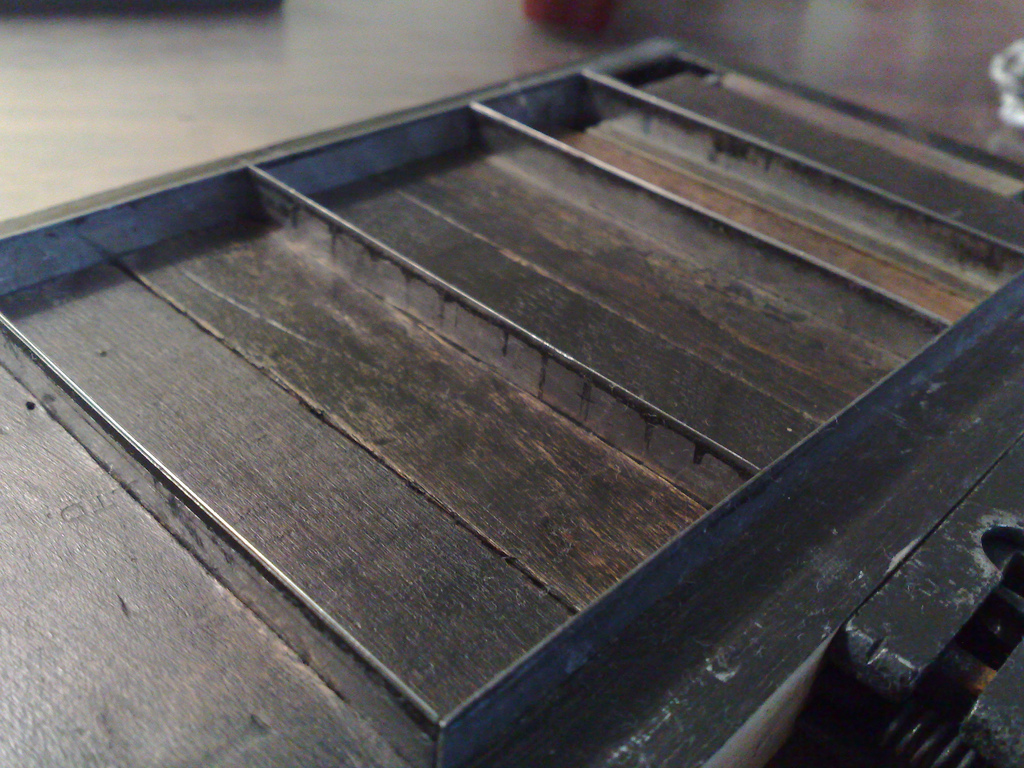
I put the set rule on the press and printing up 10 pages on half-letter-sized card stock that was leftover from my Kwik Kopy printing demonstration:
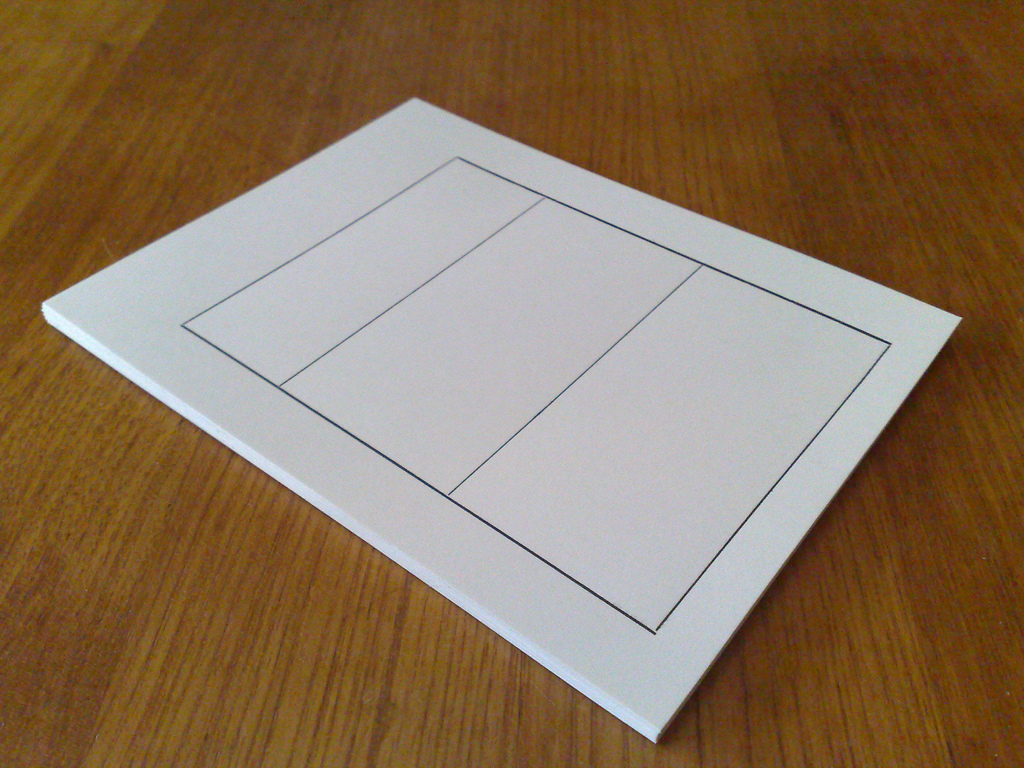
I stapled one end in three places (using the new “one touch” super-stapler that Johnny gave me for my birthday; it can staple, with no effort, through up to 25 pages!):
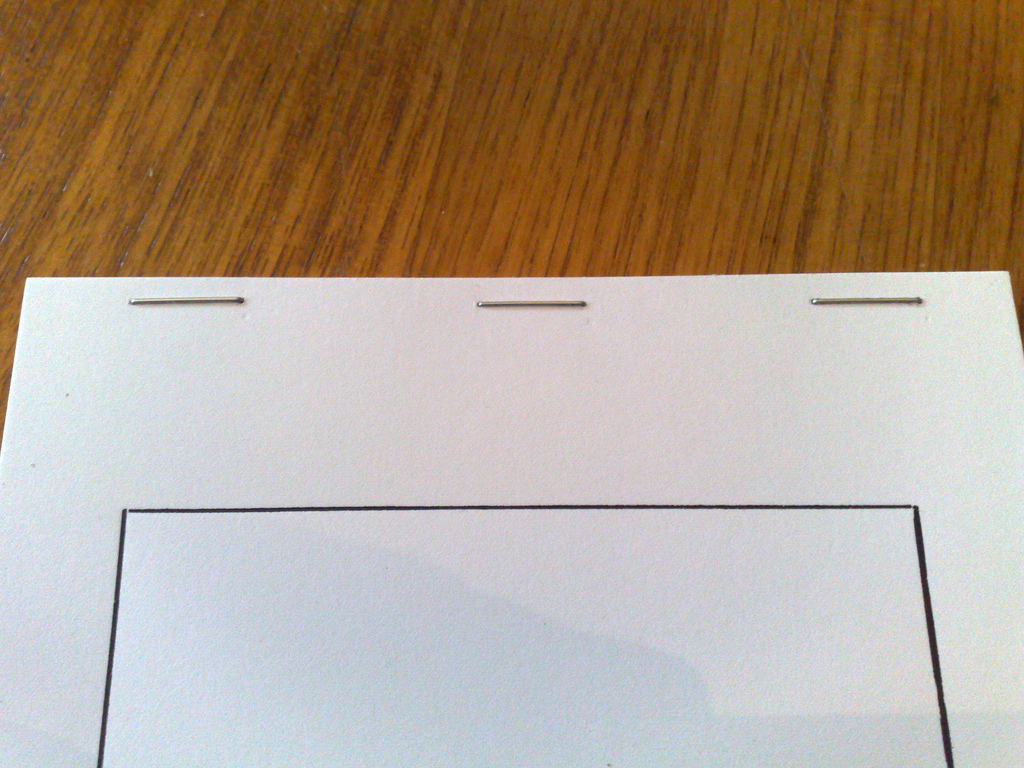
Next, for the cover, I cut and scored a piece of yellow card-stock that Catherine brought back from Halifax last fall:

I glued the cover to the stapled pages:
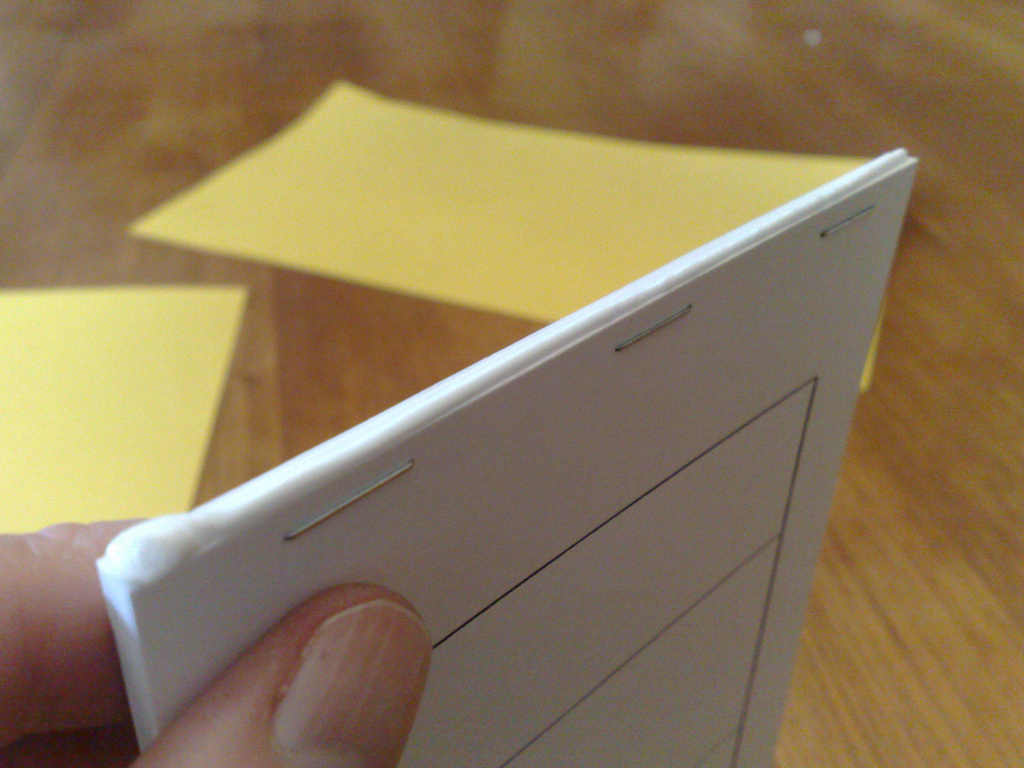
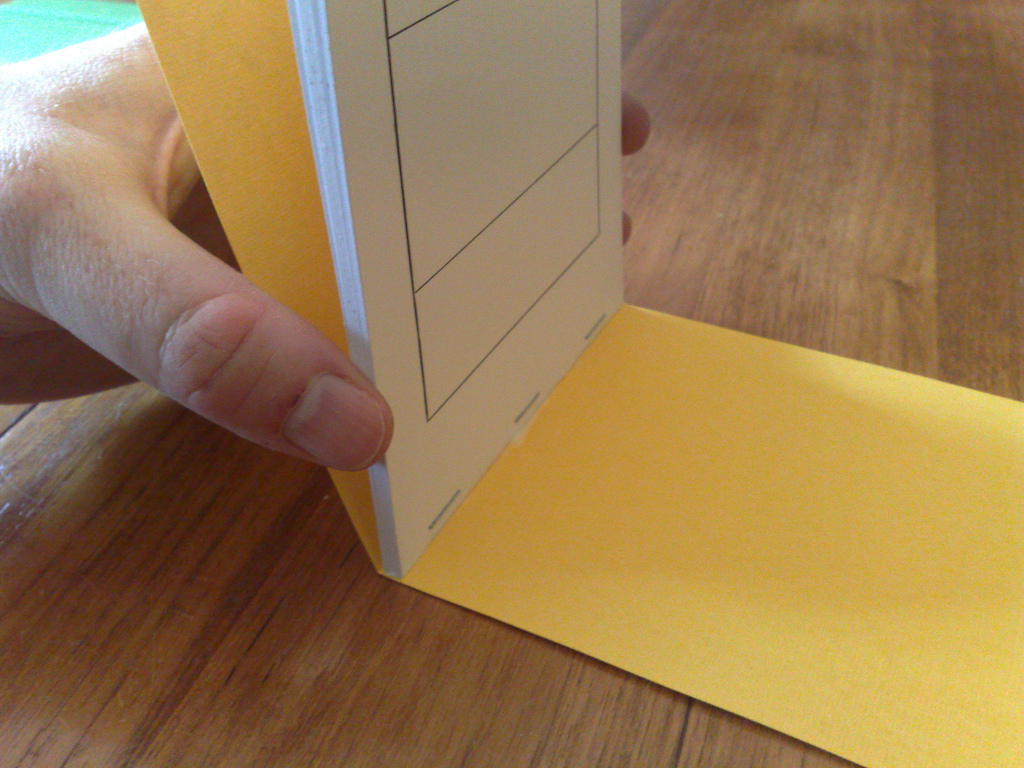
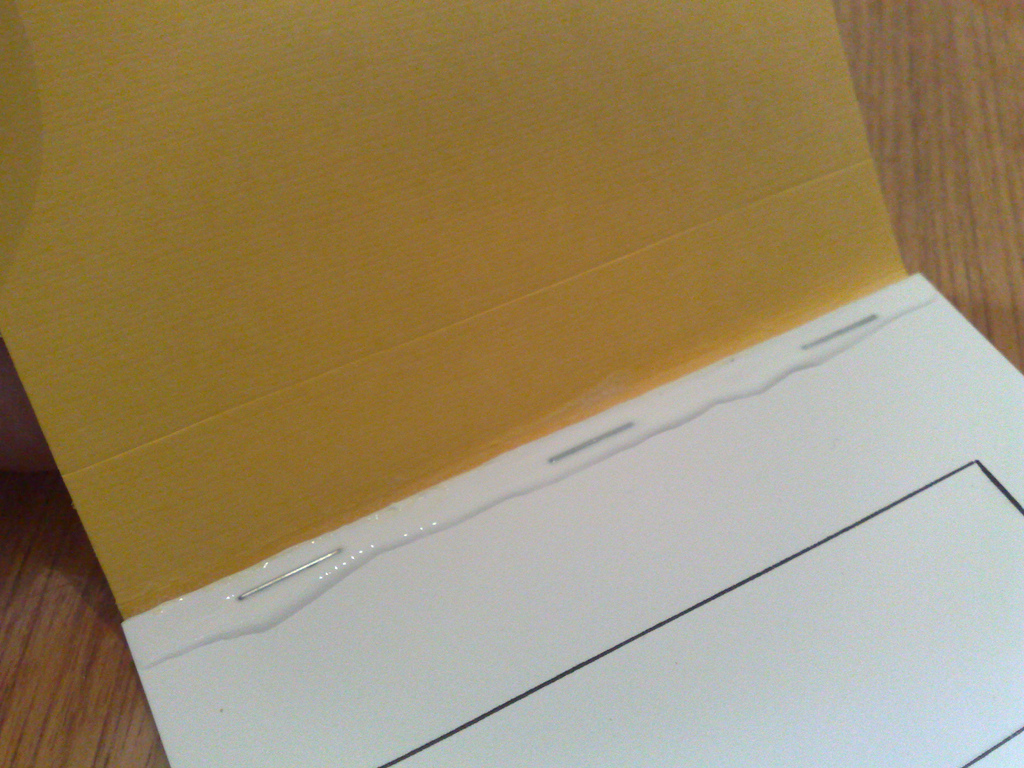
And clamped the glued-up result with binder clips to dry:

Here’s the finished book:

What might you use it for? With apologies for my still-at-grade-two-level drawing skills (is it any wonder I seek solace in the arms of metal type), something like this:

As usual when book-making is the subject, tip of the hat to Hamish and his DIY Book podcast, the source of everything I know about making books.
You can tell a lot about a person by the car they drive. And, I presume, by the television series they have set up to record on their DVR. I was cleaning up the DVR last night in anticipation of going away for the summer, and here, in chronological order of date of first entry, are the television series I had set to record. Of particular note are series like ER that have been off the air for a while, and series like Journeyman, Flash Forward and Dirty Sexy Money, that were short-lived.
- The Unit
- Saturday Night Live
- Journeyman
- 30 Rock
- The Office
- ER
- House
- Lost
- Dirty Sexy Money
- Fringe
- My Own Worst Enemy
- The Apprentice:UK
- NUMB3RS
- Worst Week
- 24
- Chef School
- Lie to Me
- Amazing Race 14
- Southland
- Extras
- Shark Tank
- NCIS
- Flash Forward
- Law & Order
- Amazing Race 15
- The Deep End
- Kitchen Nightmares
- Amazing Race 16
- Daily Show With Jon Stewart
- Californication
- Mad Men
- Community
- Rubicon
- My Generation
- Amazing Race 17
- Human Target
- Modern Family
- The Event
- Blue Bloods
- The Big Bang Theory
- CBC News: Compass
- V
- The Opener
- Season 25: Oprah Behind Scenes
- Amazing Race: Unfinished Business
- Glee
- CHAOS
- Jamie Oliver’s Food Revolution
- Happy Endings
- The Kennedys
- The Voice
- Love Bites
I presume that a trained psychographic artists could, with that list in hand, tell my birth date, brand of shampoo and political tendencies.
As reported in this space last month, after more than 10 years in operation Formosa Tea House in Charlottetown is closing.
But, as it turns out, it’s not really closing at all, simply reinvented itself under new stewardship.
If you’ve been around the neighbourhood over the past few weeks you’ve probably noticed the new paint job and the bevy of volunteers swarming over the building at 186 Prince Street. I was as curious as the next guy as to what was going on, and while I heard suggestions of the involvement of The Great Enlightenment Buddhist Academy in its re-imagining, I didn’t really know what this would mean.
Early this week, though, I was sent word through an intermediary that my presence was requested at 186 Prince on July 7 at 7:00 p.m. (7/7 at 7) for either a closing ceremony or an opening ceremony, or perhaps both. I wasn’t quite sure what to expect, but as a longtime member of the Formosa Tea House family, I felt duty-bound to attend.
On arrival I was greeted by both Mr. Lu, the new owner of the soon-to-be-named Splendid Essence, and by my old friend Chien-Ming Yeh founder, with his wife Fen, of the Formosa Tea House:
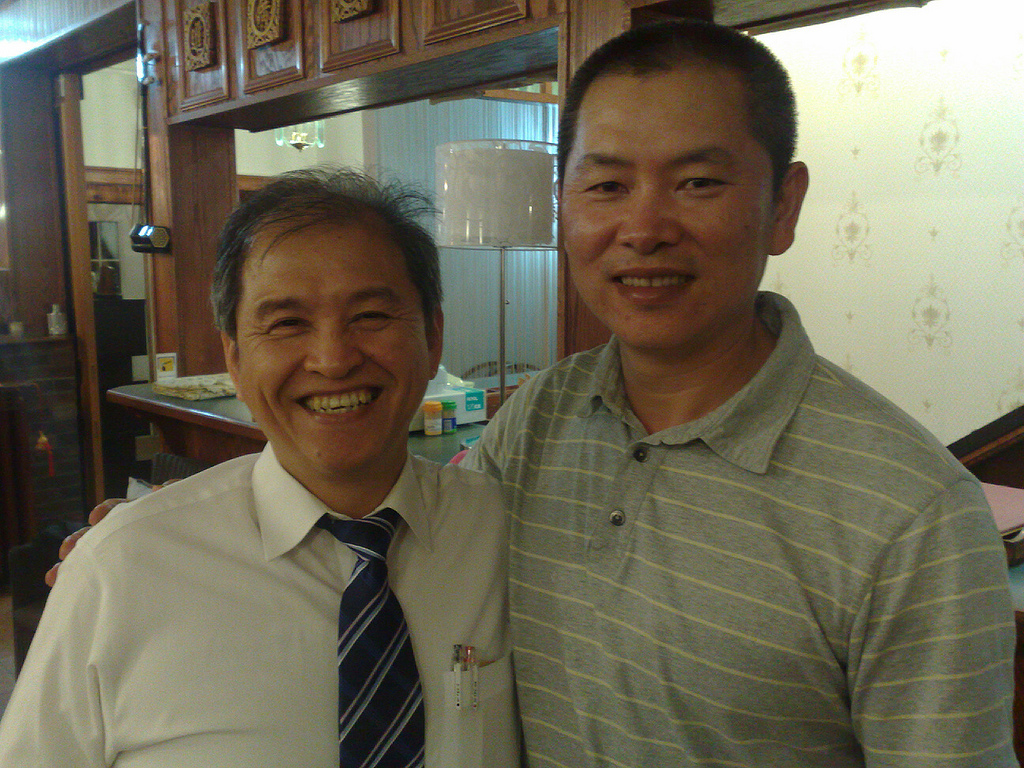
What followed was a fascinating cross-cultural three hours of food, fellowship and leaning.
And what I learned is this: in the practice of Buddhism there are, shall we say, “sub-religions” – followers of particular strands of the faith, adherents to a particular spiritual leader. In this case, the same Buddhist sect from Taiwan involved in the The Great Enlightenment Buddhist Academy and related monasteries in Montague and Little Sands has a group of lay adherents who have purchase the Formosa Tea House and will run it as Splendid Essence, evolved but following the same general “tea house” model as Chien and Fen have established. This effort appears to be a part of a broader economic and educational effort that in Taiwan involves organic farming, vegetarian food manufacturing and other endeavours.
The large crew of workers we’ve seen in recent weeks painting and renovating 186 Prince Street are a group of visitors to the Island, adherents of the faith, here volunteering their time and energy. Among those that I met last night were a retired colonel in the Taiwanese army, a computer engineer and a former graphic designer for Honda cars and motorcycles. I also met Geoffrey Yang, already here on the Island for two years and living in Stratford, who’s a sort of “real world liaison” for the monks, conducting their business affairs, and acting as assistant to Mr. Lu.
Mr. Lu is here to run the Splendid Essence; also a lay member of the sect, he has a background in organic agricultural and non-food additive manufacturing in Taiwan. His plans for the tea house include expanding its menu (while keeping the core than Chien and Fen established), and engaging in other educational and economic pursuits in the community.
This is all at once interesting, heartening and deeply, deeply weird to me. I’m very attracted to the notion of “non-capitalist enterprise,” and there’s a lot of philosophical overlap between my approach to economic matters and theirs. And it seems that if anything the special place that Formosa Tea House has had in the community will only be enhanced under this new ownership.
But I find the Buddhism angle perplexing – faith and religion of any sort are, as regular readers might recall, all a great mystery to me – and I’m not quite sure where to slot the laypeople I met last night in my everyday cast of characters: missionaries? religious people on retreat? CUSO-like volunteers? As much as I enjoyed myself last night, and was engaged by their company, there’s also a certain amount of “so this is how you win over converts through food and subtlety” paranoia in the background of my mind. I don’t wish to ascribe ulterior motives to this group; this is simply a case of that which confuses me makes me suspicious and afraid (a solid Prince Edward Island trait if there ever was one).
All that aside, the tweaks that have been made to 186 Prince are quite nice; the old back room – the original Live from the Formosa Tea House recording studio – has been transformed entirely:
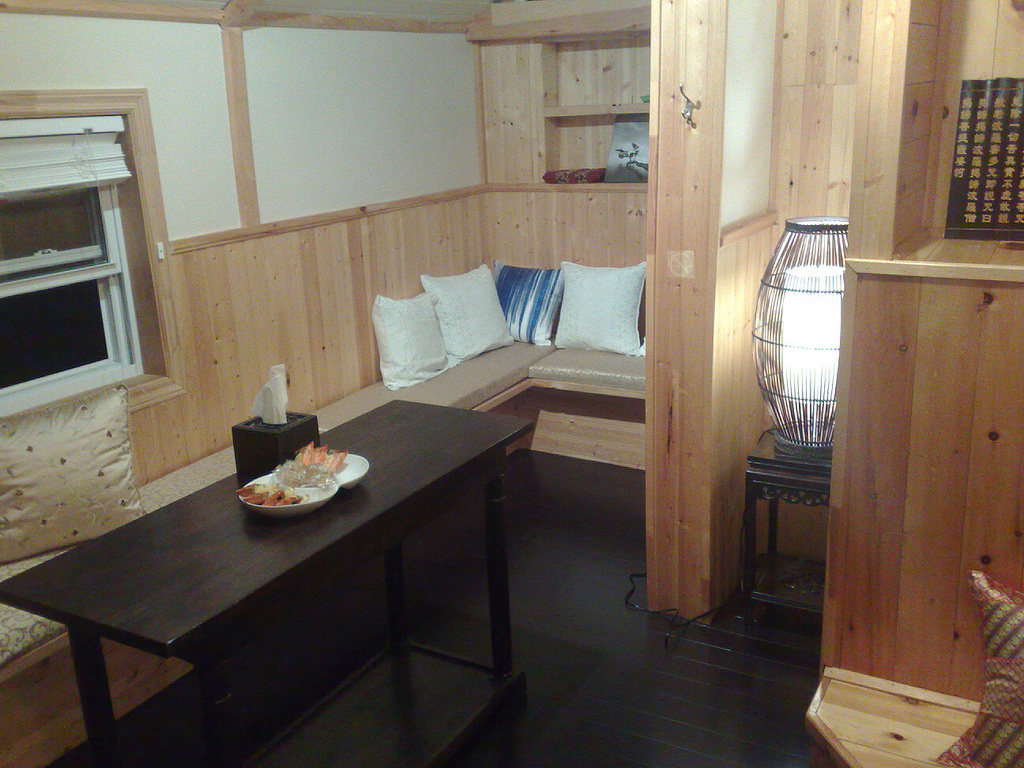
And the main room has been simplified and softened, with the booths reupholstered, pillows added, and some of the clutter removed:
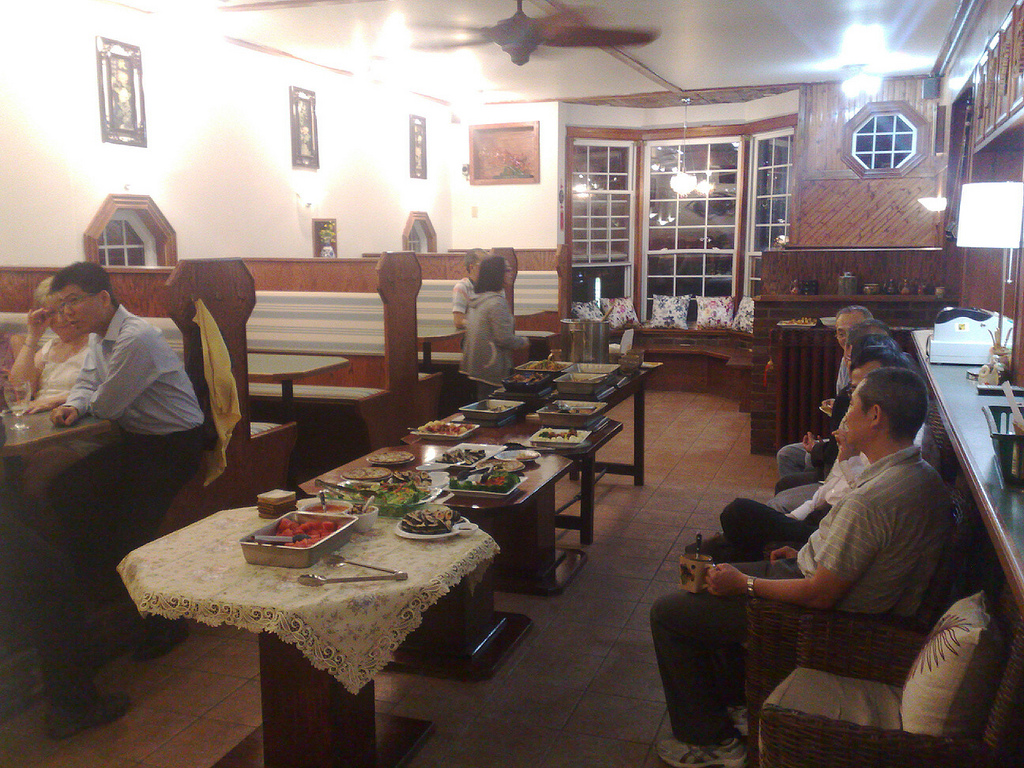
The spread they put out for we visitors – mostly Formosa regulars – was about as good as it gets in the “vegetarian buffet” world: some Formosa standbys like spring rolls and dumplings supplemented by some spicy new dishes, fresh watermelon, a very tangy soup, and some packaged desserts from the home office in Taiwan:
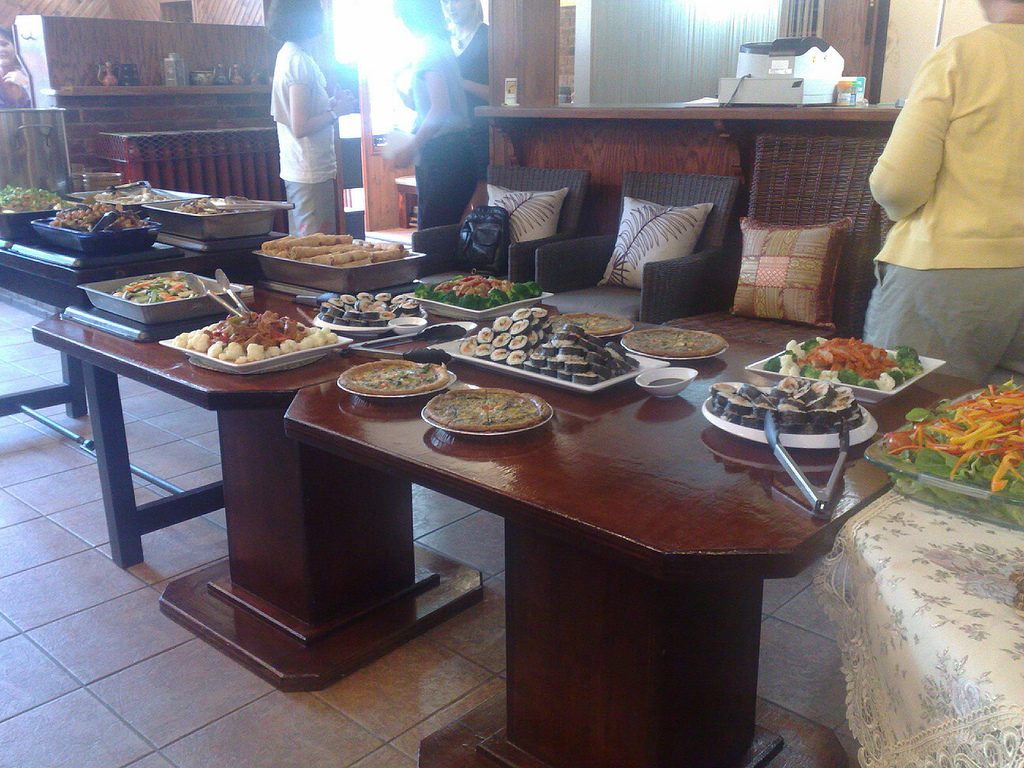
Fen will be staying around until the end of July to help the new owners with the transition; Chien left at the crack of dawn this morning for the North Sydney ferry and the drive onward to St. John’s where he and Fen will make a new life for themselves. They both seem very happy with the new path the Formosa is set on, content that they’ve left a legacy of a special and important place in Charlottetown that will stay that way.
If you’re curious about all of this, one opportunity to learn more is the Gratitude Fest this Sunday that the Great Enlightenment Buddhist Institute Society is hosting in Montague from 10:00 a.m. to 3:00 p.m. This is the Montague outpost of the group; it’s the old Lobster Shanty location for those of you that remember where that was. It’s describe as follows:
GEBIS and followers from Prince Edward Island, Ontario, British Columbia, New York, California, and elsewhere, will organize exhibits, seminars, family activities, and storytelling, on issues such as organic farming, saving the planet, gratitude, and Buddhism.
Chinese delicacies will be provided courtesy of Splendid Essence Restaurant.
If I can find the time in my busy Sunday – I’ll be madly making last-minute preparations for my Monday departure for Berlin – I’m going to try and make it out.
Three months ago I reported on a personal effort I’d undertaken to work to get real time wind energy generation from provincially-owned wind farms here on Prince Edward Island available to the public as open data. My reasoning was two-fold: I want the public to be more aware, even if only peripherally, of how much wind energy we’re generating here, and I want to be able to build – and stimulate others to build – applications on top of this and other open energy data.
My meeting in March with Hon. Richard Brown, Minister of Environment, Energy & Forestry was positive, and Richard is behind this effort entirely; I had high hopes we were on the right track.
The first work to come out of this effort was a stop-gap project based on abstract data; at best it allows us to infer wind energy generation, but not to get at the real numbers.
To get at the actual data requires tapping into what I’ve learned is called the SCADA system for the wind farms – this stands for “supervisory control and data acquisition” and it’s a favoured buzzword of the industrial monitoring crowd. In the case of provincially-owned wind farms this means tapping into the SCADA system provided by Vestas, the wind turbine manufacturer and the company that has the contract to maintain the wind energy infrastructure on PEI.
Unfortunately there are a few technical challenges in achieving this “tapping in,” primary among them is that VestasOnline, the company’s SCADA system, isn’t designed with “open data” in mind; indeed it seems specifically designed to prevent wide-scale distribution of data: it’s a PC-based proprietary system that requires an expensive “dongle” in the computer it’s running on and while it seems to be perfectly fine for someone to monitor wind farms from their desktop – this is how department staff monitor wind farms from their desks in Charlottetown – there’s no obvious way to get real time data out of the system and onto the web.
There’s another problem that’s limited to the North Cape wind farm, and that is that the SCADA system there is only reachable by a single dial-up connection, so the best one might achieve is occasional “polling” of the data rather than real time access.
My working theory on how we might open up the data – and when I say “we” I mean me and the province working together in a completely voluntary effort – is to write some custom code that would pull data from the database that the VestasOnline software archives its data into. Because I don’t have technical documentation on VestasOnline I’m only assuming that it uses some non-encrypted open database format; I may be naive in this assumption.
To be able to find this out – to test my naive assumptions, in other words – requires access to an actual VestasOnline system: fortunately there’s a secondary system that the province owns that could act as this testbed; unfortunately after three months this system is still awaiting installation and configuration, so I haven’t been able to make any progress on this front.
I had another meeting with Minister Brown this week to get updated on the project, a meeting prompted, in part, by the CBC Spark episode on my early efforts; Richard’s office is going to work with the computer services folks to gear up the VestasOnline server, and they’ll either take over the “can we get the data out” effort themselves, or get me access to it to find out.
So we’re not there yet, but we’re heading in the right direction.
About once every 5 years I need to buy a new Sharpie brand marker. I don’t use a Sharpie very often, but there are two or three things – writing on CD-ROMs, labeling file folders, etc. – that I only use a Sharpie for, and a single one thus lasts me half a decade.
Yesterday I went up to Staples in Charlottetown to buy this lustrum’s indelible marker. Except at Staples – a big box office supply store – you cannot buy a single regular old Sharpie:

The best I could do was, for $2.49, buy a single “Two Tips in One!” Sharpie that’s actually much heftier than I prefer.
An example, alas, of everything that’s wrong with the way retailing is trending.
You know those commercials they ran a few years ago espousing the virtues of flying from Charlottetown rather than from Moncton or Halifax because of the savings in time, gas, bridge tolls, hassle, etc. It turns out they’re true.
I’m rendezvousing with Catherine and Oliver in Halifax next Monday – they’re flying in from Ottawa – and we’re flying on Condor to Germany.
Because we’re going away for 6 weeks, the usual “drive to the Airport hotel, park the car, get 14 days of free parking” plan doesn’t work this time, leaving me looking for alternatives ways to get to Halifax for a late evening departure. And then getting all three of us back to Charlottetown on August 26 in the late afternoon.
Here are our options:
- PEI Express Shuttle – Leaves Charlottetown at 11:15 a.m., presumably arriving around 3:00 p.m., so a 8-hour wait in the airport. Only returns to Charlottetown at 7:30 a.m., so would require an overnight stay in Halifax on the return journey. $230 for the shuttle plus $100 for hotel for a total of $330.
- Advanced Shuttle – Leaves Charlottetown at 7:45 a.m., arriving 11:30 a.m., so an 11 hour wait in the airport. Only returns to Charlottetown at 3:45 p.m., to early for us, so would require an overnight stay in Halifax on the return journey. $245 for the shuttle plus $100 for hotel for a total of $345.
- Acadian Lines – Leaves Charlottetown at 7:45 a.m., arrives at 12:30 p.m., so a 10-hour wait in the airport. Only returns to Charlottetown at 8:05 a.m., so would require an overnight stay in Halifax on the return journey. $228 for the shuttle plus $100 for hotel for a total of $328.
- Drive my own car and park at the Halifax Airport Hotel – I can leave and arrived whenever I want. $80 for gas, $50 for bridge toll, and $40/week for parking, for a total of $370. (Parking at Holiday Inn Express is the same $40/week; at the Hilton Garden Inn it appears to be $29.95/week, but their clerk seemed very confused at the question; the Inn on the Lake has a 2-week maximum).
- Drive my own car and park at the airport Park’N Fly. Rate is $361, plus $80 for gas and $50 for tolls for a total of $491.
- Air Canada, on Aeroplan points – Leaves Charlottetown 1:00 p.m., arriving 35 minutes later, so a 9 hours wait in the airport. 10,000 Aeroplan miles and $72 in taxes and fees on the way there. No availability for 3 people on August 26th, so we’d have to fly on the 27th and spend most of the day in a hotel. Return would be 30,000 Aeroplan miles and $238 in taxes and fees. So a total of $410 and 40,000 Aeroplan miles.
- Air Canada – flying without Aeroplan means a much more flexible schedule, leaving Charlottetown at 7:45 p.m. on the way there and leaving Halifax at 6:50 p.m. on the way back, so no need for a hotel. But convenience costs: total air fare $876.
- Renting a car and driving – Hertz is $149 one-way rental on the way there and $223 on the way back. Plus $80 in gasoline and $50 in bridge tolls for a total of $502.
- Driving to Sackville, NB, parking (somewhere) and taking VIA Rail to Halifax, then shuttle to airport – Leaves Sackville at 1:34 p.m., arriving Halifax at 5:10 p.m. Return requires an overnight stay, leaving Halifax at 12:15 p.m. Train fare is $129, shuttle from Halifax to Airport is $19.50 each. And then bridge tolls of $50, gasoline of $40 and hotel for a total of $297 plus whatever it would cost to park.
I’m welcome to other suggestions!
When Dan and Steven and I recorded a new episode of Live from the Formosa Tea House last week one of the things I was reminded of is that it’s been almost 8 years that Reinvented has been resident in 84 Fitzroy Street with silverorange as our landlord. Here’s what my office looked like the day I moved in:
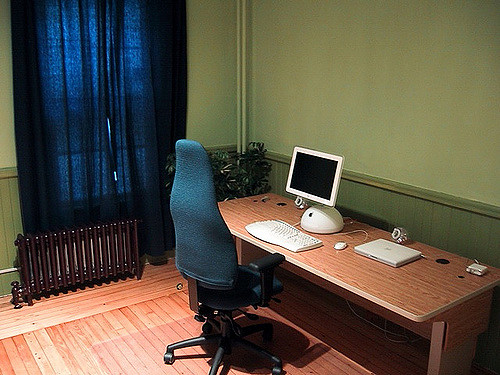
Since that day my office has seen the gradual accumulation of cruft: piles of file folders tucked into the corner with my 2004 tax receipts and cancelled cheques, transit tickets from Copenhagen, ferry tickets from Venice, currency from a half dozen countries, boxes of various cables and connectors that I might someday need again, a closet full of boxes for things like “iWork ‘05” and the Linksys router I bought 7 years ago. And install CDs from Mac OS X Tiger, Leopard, Snow Leopard, etc.
I’d mostly thought of this digital and analog detritus as benign and inevitable; I reasoned, in the rare occasions I noticed it all, that when I had a free moment I’d clean it all up and return the office to its virgin state. And then I wouldn’t.
This week, though, circumstances conspired me to action. First, I leave in a week for almost two months, and there’s nothing like the procrastinatory energy of an impending immovable deadline to get one moving (in this case I should be doing the corporate year-end paperwork, but I’m not). Second, I was reminded of Bruce Sterling’s take, which I was first exposed to at the closing of reboot 11 two years ago and more recently in his The Last Viridian Note where he writes, in part:
The hours you waste stumbling over your piled debris, picking, washing, storing, re-storing, those are hours and spaces that you will never get back in a mortal lifetime. Basically, you have to curate these goods: heat them, cool them, protect them from humidity and vermin. Every moment you devote to them is lost to your children, your friends, your society, yourself.
It’s not bad to own fine things that you like. What you need are things that you GENUINELY like. Things that you cherish, that enhance your existence in the world. The rest is dross.
Do not “economize.” Please. That is not the point. The economy is clearly insane. Even its champions are terrified by it now. It’s melting the North Pole. So “economization” is not your friend. Cheapness can be value-less. Voluntary simplicity is, furthermore, boring. Less can become too much work.
While a lot of my accumulation of dross was due to sheer laziness, a lot of it was, indeed, routed in this false notion of “economy.”
What if I ever needed to return that mixing board I bought; shouldn’t I keep the original box around just in case? What if Oliver wants to see what the original iPod looks like; shouldn’t I keep it around, even though it doesn’t work any more? You can never have too many cable ties! Or 4-foot lengths of Ethernet cable. Or CDMA mobile phones from the 1990s. Or John Kerry for President buttons. Or Altoid tins.
Well, actually, it turns out that you can.
So yesterday I spent much of the afternoon in a wild cleaning frenzy. And I lowered the economy bar much, much lower than I ever had. I threw away those shoes that I loved but that were worn out. And that electric fan that wobbled too much. And all the software and hardware empty boxes. And the Altoid tins (“but what if I want to hack together an Arduino-based geolocation device and house it in an Altoids tin” my mind screamed; I ignored it). And the John Kerry for President button.
I shredded two bags worth of paper (scanning what I needed to retain for posterity or legality), almost burning out the shredder in the process.
My office isn’t quite back to its virgin 2003 state, but I’m getting closer than I’ve ever been, and the number of piles of things on the floor has diminished greatly and I can actually use my office closet to store actually useful things for the first time.
Today’s task is to attack the tower of CDs still lurking in the closet, and then to look at the 3 or 4 linear feet of files piled over there in the corner. With those done, and a rationalization of the milk crates and cardboard boxes filled with serial cables and broken routers and old copies of The Old Farmer’s Almanac, I’ll perhaps be as close as it’s possible to get.
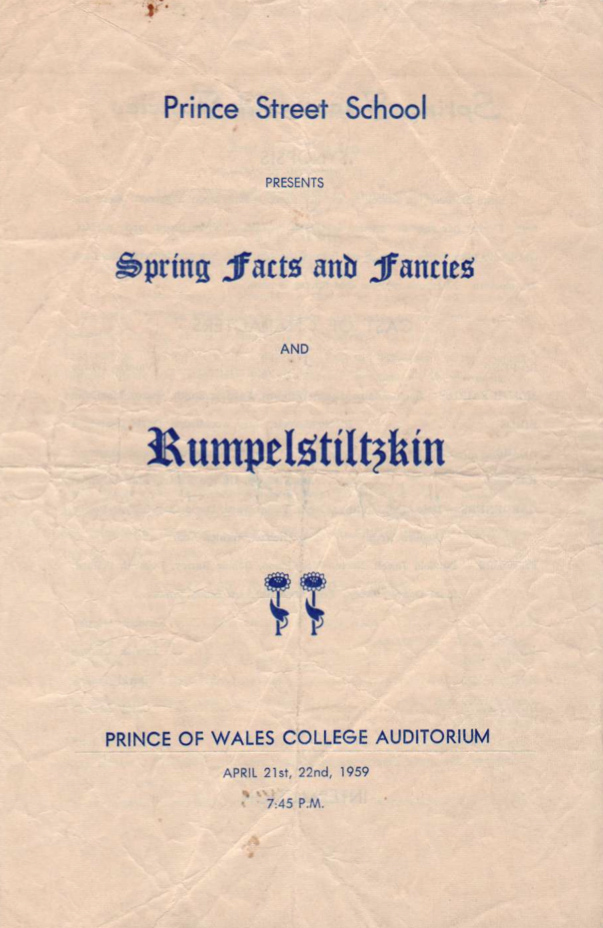
On April 21, 1959 Prince Street School presented Rumpelstiltzkin in the Prince of Wales College Auditorium. My friend G. was in the cast and, as is his wont, he saved the program, which he loaned to me to scan and preserve online.
Among the cast and crew you’ll find the names of many people alive and well and still living on Prince Edward Island today.
You can read the entire thing in this PDF file of the Rumpelstiltzkin program.
The common thread running through a lot of my work recently is this: if we become more aware of the metrics related to our everyday life we gain a deeper understanding of our behaviour and are more likely, and more able, to affect positive change.
Whether this so-called “personal telemetry” concerns bandwidth or energy, or physical fitness, being directly or peripherally aware of our consumption and action patterns is a useful tool for understanding more about ourselves.
In 2010 the Province of Prince Edward Island spent $3,655 per capita on operating health expenses. Health spending consumes 30% of the provincial budget every year, over $444 million in last year; it’s the largest slice of the provincial budget by far.
So you’d think it might be a good idea, personal telemetry-wise, if we all were more conscious of our personal impact on this budget item. To that end, back in May I sent an email to Health PEI, the provincial body here on Prince Edward Island that manages the health system:
I’m interested in obtaining a digital record of the transactions under what I would call, for lack of knowledge of the terminology, my “health care account” — in other words, all of the payments to doctors, specialists, hospitals, labs, etc. paid out by Health PEI attached to my Health Card account for as long as records are available.
I had no idea what I’ve been costing the health system; if you told me it was $10,000 over 18 years I’d be as likely to believe you as if you told me it was $2 million. I figured if I had a greater sense of what ever visit to the doctor was costing the system, I’d factor this into my decisions about, say, whether that head cold really warranted a trip to the doctor or not.
A few days later came a reply to my query:
Our Information Co-ordinator has indicated to me that you should submit a FOIPP (Freedom of Information and Protection of Privacy) request. Attached is the Access to Information form which you can complete and submit to our co-ordinator.
And so I that same day I sent in my FOIPP request:
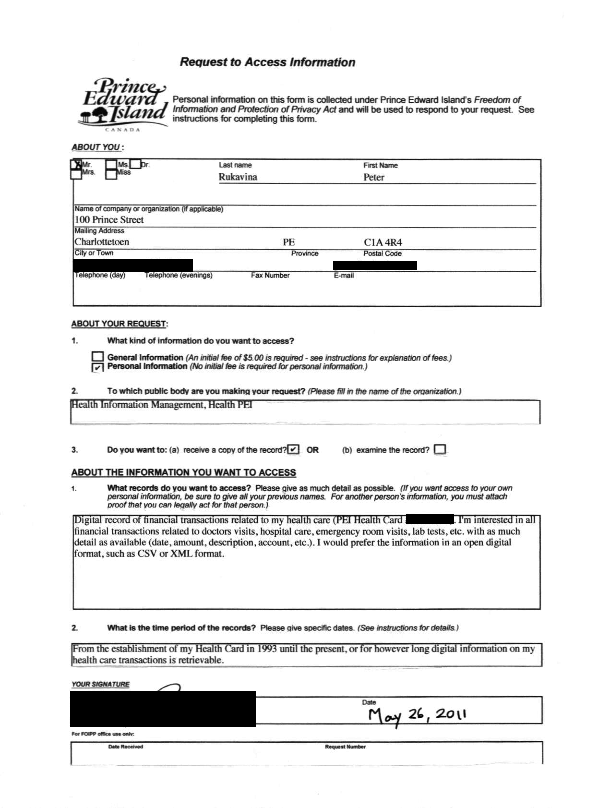
What I asked for was:
Digital record of financial transactions related to my health care (PEI Health Card # XXXXXX). I’m interested in all financial transactions related to doctors visits, hospital care, emergency room visits, lab tests, etc. with as much detail as available (date, amount, description, account, etc.). I would prefer the information in an open digital format, such as CSV or XML format.
I received a quick response to my request, saying, in part:
We will provide the information available to you under the Act as quickly as possible. Although the Act allows a maximum of 30 days to respond, we will reply sooner than June 27, 2011, if possible.
A month to the day after I sent my request I received the formal reply to my request:
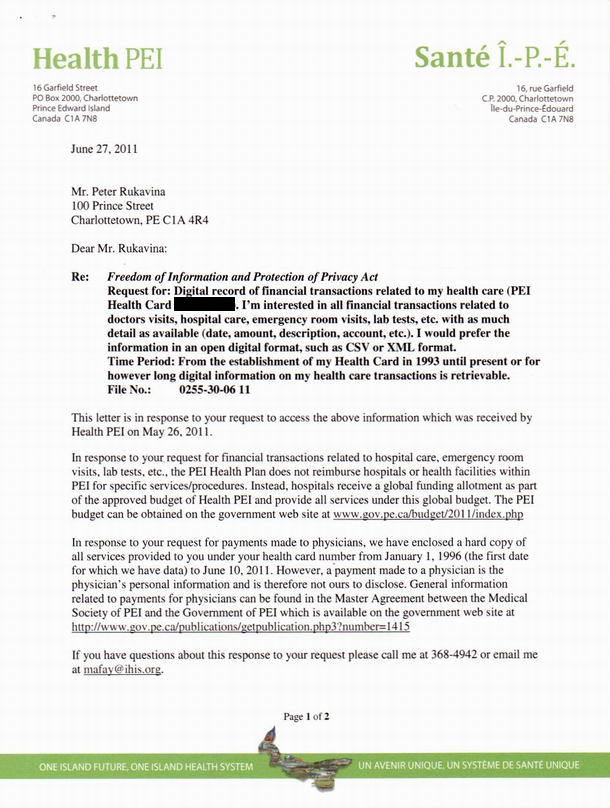
The response included a two page print-out (ignoring my request for digital information) that listed my “resident history” of health transactions from January 1, 1996 to June 20, 2011, like this:

There are 58 transactions in total, covering visits to my family doctors, to walk-in clinics and to the Queen Elizabeth Hospital. There are several pieces of information that I know to be inaccurate – procedures that happened at Prince County Hospital in Summerside, for example, that are listed as having happened at the Queen Elizabeth Hospital in Charlottetown; or an item described as “abnormal weight loss” that was actually my annual physical (that involved no weight loss at all) – but otherwise it seems like a pretty complete review of my interactions with the health system.
But no financial information was included at all, which defeats the purpose of my request.
This was explained in two parts; regarding hospital visits:
In response to your request for financial transactions related to hospital care, emergency room visits, lab tests, etc., the PEI Health Plan does not reimburse hospitals or health facilities within PEI for specific services/procedures. Instead, hospitals receive a global funding allotment as part of the approved budget of Health PEI and provide all services under this global budget. The PEI budget can be obtained on the government web site at www.gov.pe.ca/budget/2011/index.php
Although it’s an unsatisfying response, if they don’t track spending on a patient-by-patient basis there’s nothing that they have that they’re not providing me, so nothing more that I can request.
The response regarding payments to physicians, however, revealed information that they do have but they’re specifically denying me access to (emphasis mine):
In response to your request for payments made to physicians, we have enclosed a hard copy of all services provided to you under your health card number from January I. 1996 (the first date for which we have data) to June 10, 2011. However, a payment made to a physician is the physician’s personal information and is therefore not ours to disclose. General information related to payments for physicians can be found in the Master Agreement between the Medical Society of PEI and the Government of PEI which is available on the government web site at http://www.gov.pe.ca/publications/getpublication.php3?number=1415
The “Master Agreement” referenced in this explanation is a 205 page document containing a 149 page Tariff of Fees. The “description” column in the list of transactions I was provided with doesn’t relate directly to the tariff – for example, I had my gallbladder out in April of 2003 and this is listed on the sheet that I was provided as four items:

There are two “Cholelithiasis Nos” items, a “Oth Spec Prob Influenc Health” item and a “Day Surgery - Hospital Payment” item. None of these are tariff descriptions, and so there’s no way for me to determine what the cost to the health system of each was.
I dispute the assertion that “a payment made to a physician is the physician’s personal information and is therefore not ours to disclose.” The Freedom of Information and Protection of Privacy Act, section 15, paragraph 2(f) reads:
A disclosure of personal information is not an unreasonable invasion of a third party’s personal privacy if the disclosure reveals financial and other details of a contract to supply goods or services to a public body.
That description seems, to my eyes, to map directly to this situation. I have 65 days from the receipt of Health PEI’s response to as the Information and Privacy Commissioner to review the response, and I’m drafting that letter now. I’ll report back when they reply.
Well, that was disconcerting: I was looking for a link to “Green Mountain Letterpress” in Google, and between search results pages two and three Google appears to have launched a redesign of its search results page:

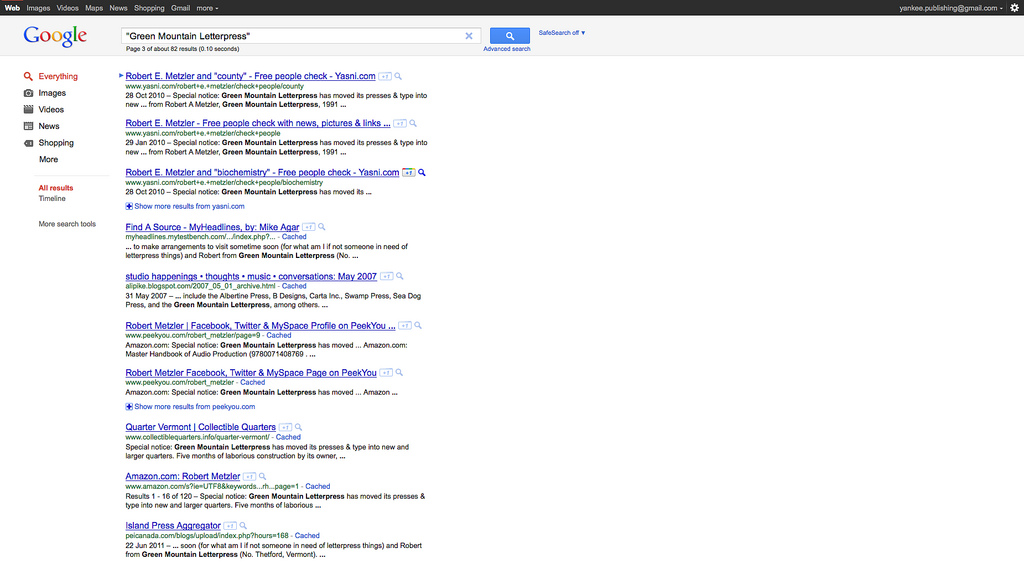
 I am
I am